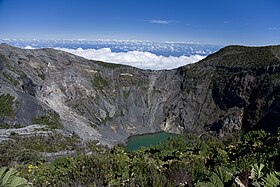Irazú Volcano
| Irazú Volcano | |
|---|---|

Irazú Crater
|
|
| Highest point | |
| Elevation | 3,432 m (11,260 ft) |
| Coordinates | 9°58′45″N 83°51′09″W / 9.97917°N 83.85250°WCoordinates: 9°58′45″N 83°51′09″W / 9.97917°N 83.85250°W |
| Geography | |
| Parent range | Cordillera Central |
| Geology | |
| Mountain type | Complex Stratovolcano |
| Last eruption | December 1994 |
The Irazú Volcano (Spanish: Volcán Irazú) is an active volcano in Costa Rica, situated in the Cordillera Central close to the city of Cartago.
The name could come from either the combination of "ara" (point) and "tzu" (thunder) or a corruption of Iztarú, which was the name of an indigenous village on the flanks of the volcano. In Costa Rica it is known by the name of "El Coloso" (The Colossus) due to the catastrophes that it has provoked in the past.
The volcano's summit has several craters, one of which contains Diego de la Haya, a green crater lake of variable depth. At 11,260 feet (3,432 m), the Irazú Volcano is the highest active volcano in Costa Rica. It is easily visited from San José, with a road leading right up to the summit craters and a weekly bus service to the top. It is thus a popular tourist spot. The summit of the volcano also houses a few television transmitters for television stations in San José.
From the top it is possible to see both the Atlantic and Pacific Oceans on a clear day. However, such clear days are rare, and the volcano's summit is usually cloud-covered.
The volcano is contained within the Irazú Volcano National Park, which spreads across 5,705 acres (2,300 ha). The national park contains both primary and secondary montane forests and is home to armadillos, owls, rabbits, foxes, woodpeckers, and hummingbirds.
The Irazú volcano is a complex volcanic shield. It is the highest active volcano in Costa Rica, and has an area of 500 km2 (190 sq mi). It has an irregular subconic shape, and temperatures at its summit vary between 3 and 17 °C (37 and 63 °F), with a record low of -6 °C(21.2 °F) and a record high of 23 °C(73.4 °F). Irazu volcano is a stratovolcano with a summit elevation of 3,432 metres (11,260 ft). Its five craters are easily differentiated. The most important ones, because of their activity, are The Main Crater and the Diego de la Haya crater. The Main Crater is almost circular, has very inclined walls and it measures 1,050 metres (3,440 ft) in diameter and 300 metres (980 ft) deep. The Diego de la Haya crater is 600 metres (2,000 ft) in diameter and 100 metres (330 ft) deep. Other craters are Playa Hermosa, La Laguna, and El Piroclastico.
...
Wikipedia

